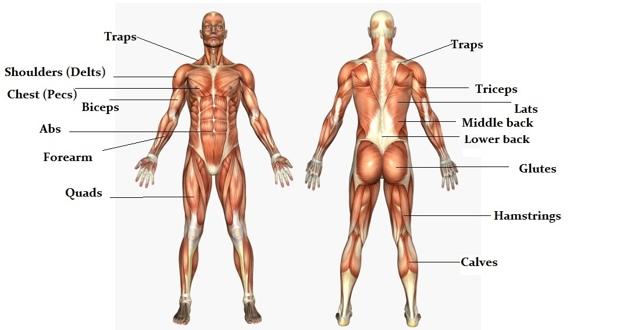
Click Here for Free Bodybuilding and Fitness Magazine Subscription
The Importance of Free Testosterone
Do you know the difference between total testosterone and free testosterone?
Did you know you can have high total testosterone, but not be experiencing the all benefits of it?
Total testosterone is is the combined total of three different forms of testosterone in your body:
Testosterone molecules bound to SHBG (Sex Hormone Binding Globulin),
Testosterone molecules bound to a protein called albumin, and
Free testosterone which isn't bound to anything - thus, it is free.
It's the free testosterone that creates all of the benefits. So it only makes sense to increase the amount of your testosterone.
Andro-Shock is designed to help boost free testosterone along with weight training, each serving contains the following 10 ingredients:
100 mg. Tongkat Ali (Long Jack), 100 mg. DHEA, 30 mg. Zinc Sulphate, 200 mg. Saw Palmetto, 150 mg. Chrysin, 350 mg. Tribulus Terrestris, 100 mg Avena Sativa, 250 mg. Muira Puma, 300 mg. Nettle Extract and 30mg. Betasistosterol.
Users of Andro-Shock have told us they have experienced...
Greater muscle gain
Faster recovery from their workouts
Increased muscle mass and strength
Deceased body fat levels
More energy and endurance
Increased sense of well being
Libido enhancement
Get some at https://www.trulyhuge.com/andro-sh.htm
You can also order Andro-Shock by calling 800-635-8970 or 503-648-1898, 10 am to 6 pm PST
Best Body Part Split

What is the Best Body Part Split to Use with High-Intensity Training
Bodybuilders love to fiddle with their routines, especially if it gives them the chance to focus more on their favorite bodyparts. That’s one of the reasons that split training is so popular: by dividing up your muscle groups across different days, you can do more exercises for each one.
But if you’re following a high-intensity training protocol, you likely already know that “standard” HIT calls for training the full body at each session. Is it possible to break that mold and still make progress?
Let’s take a look.
Benefits of Full-Body Training
Full-body training offers several benefits to hard-training lifters.
For one thing, it ensures that you hit all of your body parts because you stack them all into each workout. Split training often encourages you to focus on one muscle group at the expense of others.
Full-body routines also make sure you train the most important body parts first, because you work in order from largest to smallest most of the time. No need to worry about neglecting legs or back under that system!
Finally, full-body training is the most efficient “split” you can use because it allows you to work the most possible muscle mass in the least amount of time — typically 30 minutes or less on each of two or three weekly training days.
Drawbacks of Full-Body Training
Full-body training does have its drawbacks, especially for advanced lifters.
Hitting your entire body at once can be very draining once you’re using really heavy weights, and the smaller muscle groups can suffer since they’re stuck at the end of workouts. You will also find that your recovery time needs to be extended as you get stronger.
To combat this, many advanced HIT lifters employee three-way splits like those advocated at various times by the late Mike Mentzer, a pro bodybuilder who developed his own offshoot of HIT that he dubbed Heavy Duty.
Full-Body Split Training
For many, if not most, trainees, splitting your body parts so severely is dangerous, though. Once you are training just back and chest in one session, for example, the tendency is to add more sets and exercises and throttle back on the intensity.
That may work as a change of pace, but it’s not going to be as productive for many in the long run as all-out intensity.
Fortunately, there is another option that advanced men have been using to good effect, and which is supported by the writings of Dr. Ellington Darden, who originally coined “high-intensity training” back in the 1970s.
That option is to exercise the full body each workout but to split the exercises you use across two days and use the indirect effect to make sure you’re hitting everything. For example, when you squat, you’re training primarily quads, but your hamstrings also get powerful secondary stimulation. That means you can put off training stiff-leg deadlifts for another day.
The result is an A/B split that might look something like this:
Workout A
- Squats
- Calf Raises
- Pulldowns
- Bent Rows
- Military Press
- Lying Triceps Extensions
- Wrist Curls
- Reverse Crunches
Workout B
- Stiff-leg Deadlifts
- Seated Calf Raises
- Bench Press
- Dumbbell Flyes
- Barbell Curls
- Reverse Wrist Curls
- Crunches
This gives you the flexibility to include more exercises but also helps you avoid burning out on any one as quickly as you might when using just a single routine.
If you monitor your progress and make sure to keep your workout time in check, you can use split routines with HIT. Just be careful, because intensity is a powerful, yet potentially dangerous tool in your fitness arsenal!
Want Even More HIT Information?
If you want to learn ALL about high-intensity training to figure out if it’s the right approach for you, be sure to check out https://www.getbulky.com/high-intensity-training.html.

